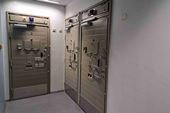The main objective of a security system at the perimeter is to be alerted of any breach or poten¬tial threat.There is a risk of false alarm activations, however, which can incur a high cost and disrupt an effective response. Security professionals consequently search for solutions which can work reliably in an ever-changing environment and can deliver a stable performance in different weather, temperature and variable lighting conditions. That is where Lidar technology can make a big difference, according to Mark Cosgrave:
“Lidar-based intrusion detection is increasingly becoming a preferred choice for perimeter security due to its proven reliability in variable lighting conditions including complete darkness and in extreme weather conditions,” he explains.
Mark Cosgrave says that the target can also be customised: “Small to medium sized animals can be ignored, keeping the focus of detection on the real potential threats, whether it’s humans, or vehicles. When integrated with good quality cameras and high-performing video management systems, Lidar enhances the security system with accurate detection which can mitigate false alarms and allows to locate real threats and intruders,” he adds.
Adaptable system needed
Within high security sites and critical infrastructure there are often areas which are vital to the good operation of the site. In an airport, for instance, if there is a perimeter breach near a runway there is an immediate danger which would disrupt and shut down completely the airport’s operations. Taking the example of an oil refinery, a breach near the oil storage could present a serious threat. Mark Cosgrave believes these scenarios serve as good examples of the benefi ts of intelligent Lidar technology: “The security system needs to be able to adapt to the different threat levels and locations in order to protect highly restricted areas,” he continues. “It is something that the next generation Lidar Redscan Pro can achieve by creating different zones with different sensitivity levels and outputs. An area can therefore be set as pre-warning alert and a different area as immediate security alert.”
Virtual fenceless protection
Due to the nature of Lidar technology, an invisible laser wall or plane can be created around buildings and facilities to trigger an alert if anyone trespasses into a highly restricted area. Thanks to its advanced detection logic, Redscan Pro, for example, can use different judgement rules to determine what constitutes a real threat and what can be ignored. For instance, it can be set to raise the alert if different detection zones are crossed by an intruder as he approaches a high restricted zone, or if a vehicle of an unusual or unexpected size approaches a certain area.
Point detection
Locating exactly where the security breach is taking place is pivotal in highly restricted areas as it enables the security staff to know exactly where the threat is coming from. It also makes the visual verification process significantly quicker as cameras do not need to search an entire zone, but instead can look precisely to the point where the intruders are and track them through the detection area. “Point location is one of the key features of Redscan Pro Lidar which can facilitate the exact X,Y coordinates when integrated with high performance VMS,” Mark Cosgrave says.
Pre-alert in sensitive areas
In addition to horizontal and vertical modes, Redscan sensors allow up to a 45-degree angled detection which can be used on the perimeter as an alert before the target reaches the fence line. The target object can be defined by size and speed of movement, and it is therefore easy to ignore most wildlife, birds, rodents and cats which could be a major cause of false alarms for other technologies. This pre-alert is an extra layer of security giving advanced notice of potential security breaches.
Securing entrance points
Sites have to allow access to vehicles and people coming in and out of their facilities in order to run their operation and it is critical to protect those entry and exit points. The credentials are managed via access control management systems which are becoming ever more sophisticated to ensure only authorised vehicles and individuals are allowed in. However as soon as a gate opens, the perimeter isn’t closed anymore and it could lead to potential intrusions, such as a person tailgating a legitimate vehicle. Redscan Lidars are deployed to secure gates when they are operating and activate an alert if an intruder is entering the site while the gate is closing or through blind spots while vehicles drive in and out.
Mark Cosgrave is convinced that the use of Lidar detection technology will continue to increase, due to the demand for early effective detection and minimal numbers of false alarms:
“Withits advanced flexibility and customisation, Redscan Pro Lidar is set to be a game changer for a wide range of perimeter security applications,” he concludes.
















